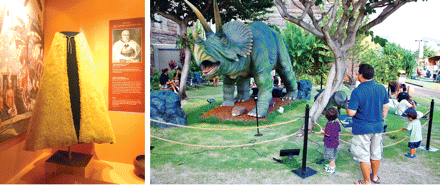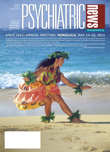The Bishop Museum in downtown Honolulu is an eclectic window into the history, natural and otherwise, of Hawaii and the Pacific Ocean.
The museum houses 1.3 million artifacts from the cultures of the island state, while the natural-sciences collection includes more than 22 million examples of plant and animal life from the Pacific basin, Polynesia, New Guinea, and even Southeast Asia.
The museum is the legacy of Bernice Pauahi Bishop, the last of the Hawaiian royal princesses. In her will, Bishop called for a museum to "enrich and delight" the residents of Hawaii.
The centerpiece of the museum's permanent collections is the three-story Hawaiian Hall, the original stone building constructed in 1889. Each floor reflects a different dimension of the Hawaiian cosmos.
The first floor is called Kai Ākea, the world of the Hawaiian gods, legends, and beliefs and other aspects of Hawaiian life before European contact.
The second floor, Wao Kanaka, displays the importance of the land and nature in the daily lives of the Hawaiian people.
Wao Lani, the third floor, is the realm inhabited by the gods and, presumably by descent, Hawaiian royalty (ali'i) and the islands' history.
The nearby Polynesian Hall displays artifacts of other Pacific cultures, such as those in Polynesia, Micronesia, and Melanesia, including objects that open a window on rituals, daily life, warfare, religion, clothing, music, and dance.
Moving from the cultural landscape to the natural world, the Richard T. Mamiya Science Adventure Center presents interactive exhibits focused on the seismology, volcanology, entomology, botany, geology, and oceanography of Hawaii and the Pacific.
In the center, a wave-making tank produces a mini tsunami. A 26-foot recreation of the Puu ‘O’o vent on the Big Island's active Kilauea volcano belches steam and fountains of artificial lava.
If fake lava isn't enough of a thrill, Bishop Museum staffers heat cinders to 2,500 degrees in a small furnace to make laboratory lava. Blasts of hot air give visitors the sense of hanging over the edge of a volcano.
In addition, visitors can steer remotely operated submarines around a 32,000 gallon tank containing a mock-up of the volcanic underwater Lo'ihi seamount's hydrothermal vents. The real Lo'ihi may someday form the next island in the Hawaiian chain, if frequent earthquakes and occasional eruptions boost it the last 969 meters up to the ocean's surface.
To provide the big picture, a topographic model shows what Hawaii would look like if you pulled the plug and drained the Pacific Ocean. The entire Hawaiian Islands chain, stretching from Lo'ihi in the southeast to Kure Atoll, are just the visible tops of a large chain of mountains rising from the Pacific sea floor.
If geology pales, entomology beckons. Electron-microscope-scanned pictures of Hawaii's endemic and invasive species can be viewed on a huge video screen, while a very live termite colony works away.
During the APA annual meeting, the museum will present a special exhibition of the feathered dinosaurs from Liaoning Province, China.
The fossils discovered in Liaoning were exceptionally well preserved, permitting scientists to understand not only the structure of their feathers and wings, but also their color, as well as environmental influences that affected the lives of the dinosaurs.
This discovery has led paleontologists to re-evaluate the appearance of the ropod dinosaurs around the world.
The Liaoning fossils have also illuminated the connection between ancient dinosaurs and modern birds. Scientists now conclude that feathers first evolved as a means of warmth and display and later became specialized to enable flight.

